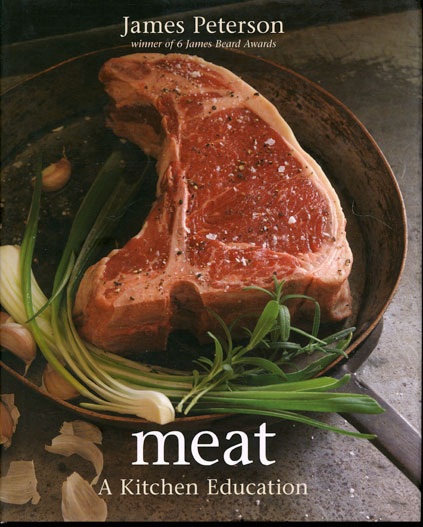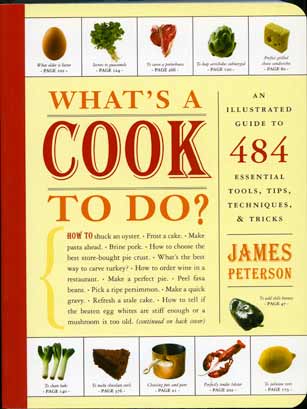Both a noun and a verb, to sauté something literally means to “jump” it. This makes sense in those cases in which sautéing is carried out by continuously shaking the pan so that what it is you’re sautéing is being constantly redistributed. This encourages the food to brown evenly and also prevents the accumulation of steam which would make the food soggy. Mushrooms are an example of a food that can be sautéed in this way. Keep in mind when sautéing such that you’re tossing the ingredients over the heat, that it’s best to use a pan with sloping sides. The sides make it easy to toss the food by jerking suddenly on the pan. The best pans I’ve found for this are French cast iron.
Sometimes sautéing doesn’t mean jumping at all but carefully turning over with tongs or fork. An example of this would be pieces of chicken. When sautéing meats or fish, use a heavy pan and one with straight, not sloping, sides. Because the pan is heavy it can be preheated and will retain heat as it’s used for the sautéing. Be sure to use a pan that will hold the food in a single layer. If the food is crowded in, it will steam; if it’s not crowded enough, the pan will burn in those areas that aren’t covered. A straight-sided sauté pan is really only necessary if you plan to make and reduce a sauce in the pan. If you try to reduce a sauce in a pan with sloping sides, the sides become covered with sauce and burn.
Usually the purpose of sautéing is to form a brown crusty (and very flavorful) layer of caramelized juice on the surface of meats, seafood and vegetables. Experts (including Escoffier) often say that this crust seals in juices and keeps further juices rom escaping, but in fact this isn’t the case. The crust does, however, retain much of the flavor of what’s being sautéed and should be encouraged. If the food starts to steam—if the pan is too crowded or the heat not high enough—the crust will break down and cause further steaming.
A sauté is also a dish. When referring to chicken (as in “chicken sauté”), a sauté is a dish in which the chicken has been cooked completely in a pan with butter or oil, the chicken removed, the fat discarded, and a sauce built in the pan. The chicken is then reheated in the sauce. A sauté contrasts with a braise or a fricassee because no liquid comes in contact with the chicken except for during the final reheating.
When the term “sauté” is applied to dishes made with red meat, it is referring to a kind of mock stew in which the meat is quickly browned without being cooked through, a sauce made in the pan, and the meat just reheated before serving. Beef Stroganoff is an example of such a dish. The trick to making a successful beef or lamb sauté is to make in essence a stew, using cheap stewing cuts and whatever braising liquid you choose such as red wine or broth. You then reserve the stewing liquid and thicken it to just the degree you like. Just before serving you quickly sauté the cubed meat, using the highest heat possible (to avoid cooking the meat all the way through while still browning it), let the meat cool (without stacking it which would cause it to steam) and then reheat it in the sauce just before serving. The magic of such dishes is that your guests are expecting a stew but then bite into rare red meat.



I’m curious to hear your thoughts on something that perplexes me:
Your second meaning of sauté (“carefully turning over with tongs or fork “) presumably means that the food items sit still for extended periods of time and are not continually moved around the pan. So, for example, a piece of chicken might be “sautéd” by being turned over only once.
How is this different from plain old “frying”? Can we speak of having a “sunny side up sautéd egg”?
Or might it be the case that “sauté” came to replace “frying (in a thin layer of fat)” because “frying” came to be increasingly associated with substantial amounts of cooking fat? If a piece of chicken can be “shallow fried” in an inch of fat and “deep fried” in six inches of fat, then why does using only a film of fat suddenly equate to “sautéd” instead of “fried” when everything else remains substantially the same? Do French kitchens use the word “sauté” in your second sense?
Just curious.
Yes. For example when we saute scallops we should carefully turn them in the pan as they brown. If they were to be tossed in the same way as zucchini, for example, they wouldn’t get hot fast enough and they would release water and steam.
All these terms have their limits. Sauteing in more than the usual amount of fat becomes shallow-frying and shallow-frying itself is almost identical to deep-frying except that it’s necessary to turn things over. Sauteing can also just be called “frying” as in your egg comparison, but I’ve tried, in my books, to give more clarity to these terms.
Yes, the word saute is used in this second sense as well as the first. When we speak loosely, we of course talk about “frying” an egg; we don’t say to “sauté” an egg. But the distinctions remain and there just to help you cook. Don’t get too hung up on the semantics.